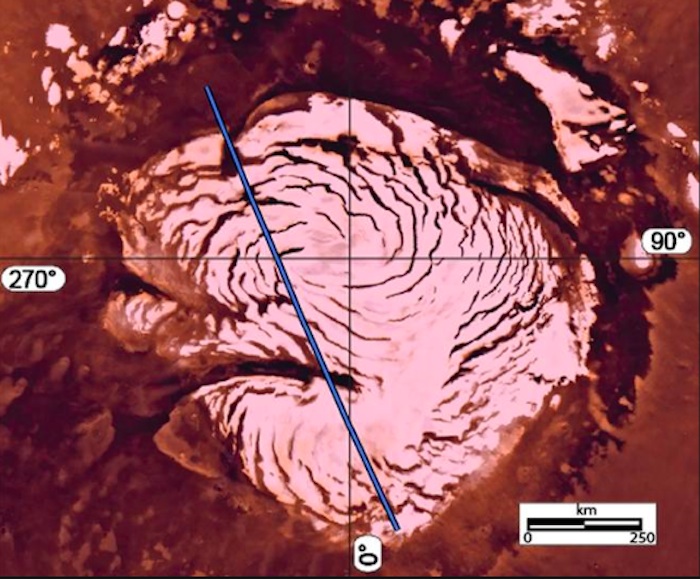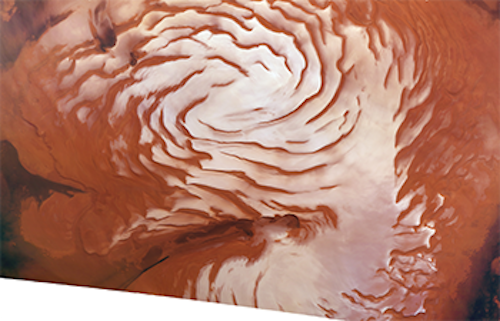.


Scientists have discovered evidence for a past ice age in the northern polar ice cap of Mars by analyzing radar images like the one at top of this montage. NASA/JPL-Caltech/Sapienza University of Rome/Handout -
An analysis of radar images that peered inside the polar ice caps of Mars shows that Earth's neighbor is coming out of an ice age that is part of an ongoing cycle of climate change, scientists said on Thursday.
The Martian ice began its retreat about 370,000 years ago, marking the end of the last ice age, according to the research published in the journal Science.
Using images taken by satellites orbiting Mars, the researchers determined that about 20,872 cubic miles (87,000 cubic km) of ice has accumulated at its poles since the end of the ice age, mostly in the northern polar cap.
Scientists are keenly interested in piecing together the climate history of Mars, which contains strong evidence that oceans and lakes once pooled on its surface, bolstering the prospects for life.
Scientists can now use the new ice measurements in computer simulations to more accurately model the Martian climate, said planetary scientist Isaac Smith of the Southwest Research Institute in Boulder, Colorado, who led the study.
"Previously those models were unconstrained by observations so they started with guesses. Now they have more to run on," Smith said.
The study also was the first to tie a specific layer of Martian ice with a specific period of time. "Eventually we'd like to be able to do this for every layer," Smith said.
From the perspective of an Earthling, every day on Mars may feel like an ice age. According to NASA, temperatures on Mars may hit a high at noon at the equator in the summer of roughly 70 degrees Fahrenheit (20 degrees Celsius), or a low of about minus-225 degrees Fahrenheit (minus-153 degrees Celsius) at the poles.
Unlike Earth, ice ages on Mars occur when its poles are warmer than average and frozen water is more stable at lower latitudes. Transitions between lengthy climate phases can leave telltale features in the ice, the research showed.
For example, Smith and colleagues found dramatic slopes in layers of ice within the Martian northern ice cap. Other layers reveal ice flowing in reverse direction. The climate cycles are triggered by changes in Mars' orbit and tilt, which affect how much sunlight reaches the planet's surface.
The shifts are particularly dramatic on Mars because theplanet's tilt changes by as much as 60 degrees, compared to variations in Earth's tilt of about 2 degrees.
-
SwRI scientists discover evidence of ice age at martian north pole
San Antonio, Texas — May 26, 2016 — Using radar data collected by NASA’s Mars Reconnaissance Orbiter, a Southwest Research Institute-led team found evidence of an ice age recorded in the polar deposits of Mars. Ice ages on Mars are driven by processes similar to those responsible for ice ages on Earth, that is, long-term cyclical changes in the planet’s orbit and tilt, which affect the amount of solar radiation it receives at each latitude.
“We found an accelerated accumulation rate of ice in the uppermost 100 to 300 meters of the polar cap,” said Dr. Isaac Smith, a postdoctoral researcher at SwRI and lead author of a paper published in the May 27 issue of Science. “The volume and thickness of ice matches model predictions from the early 2000s. Radar observations of the ice cap provide a detailed history of ice accumulation and erosion associated with climate change.”
Like Earth, modern-day Mars experiences annual rotation and seasonal cycles, as well as longer cycles, that influence the distribution of ice. However, these longer cycles might be more pronounced on Mars. This is because Mars’ tilt changes substantially — by as much as 60 degrees — on timescales of hundreds of thousands to millions of years. By comparison, the Earth’s tilt varies by only about 2 degrees over the same period. On Mars, this greater variability determines the amount of sunlight reaching a given spot on the surface and thus the stability of ice at all latitudes.
“Because the climate on Mars fluctuates with larger swings in axial tilt, and ice will distribute differently for each swing, Mars would look substantially different in the past than it does now,” said Smith. “Furthermore, because Mars has no oceans at present, it represents a simplified ‘laboratory’ for understanding climate science on Earth.”
Detailed measurements of ice thickness show that about 87,000 cubic kilometers of ice have accumulated at the poles since the end of the last ice age about 370,000 years ago; the majority of the material accumulated at the martian north pole. This volume is equivalent to a layer of 60 centimeters if spread uniformly across the surface. These results provide a means to understand the accumulation history of the polar deposits as related to Mars movements, such as orbital eccentricity, axial tilt, and rotation around the Sun. The results will support modeling efforts to understand the martian climate, looking at the movement of ice from poles to mid-latitudes during climate cycles.
“Studying ice on Mars also is important to the future of human exploration of the Red Planet,” said Smith. “Water will be a critical resource for a martian outpost.”
“An ice age recorded in the polar deposits of Mars” is published in Science. This work was funded by NASA’s Mars Reconnaissance Orbiter project.
.

Combining Mars Reconnaissance Orbiter radar data with images of Mars’ north pole, a Southwest Research Institute team found evidence for an ice age on the Red Planet. This mosaic image, produced with the High Resolution Stereo Camera (HRSC) onboard ESA’s Mars Express (MEx) spacecraft, shows spiral features that were used in interpreting the climate signal of ice age advancement and retreat. This image was cropped from a two-image true-color mosaic acquired by HRSC and specially processed by Dominik Neu and Patrick C. McGuire from the Freie Universität Berlin and the MEx/HRSC teams for this release.
Quelle: SwRI
---
Mars is emerging from an ice age
Radar measurements of Mars' polar ice caps reveal that the mostly dry, dusty planet is emerging from an ice age, following multiple rounds of climate change. Understanding the Martian climate will help determine when the planet was habitable in the past, how that changed, and may inform studies of climate change on Earth. Models have suggested that Mars has undergone ice ages in the past, but empirical data to confirm this has been sparse. Here, Isaac Smith and colleagues used radar to analyze layers of ice within the planet's polar ice caps, using the Shallow Radar instrument onboard the Mars Reconnaissance Orbiter spacecraft. As ice erodes, wind can create spiral troughs and other distinct features. Tracing the layers of these features within the ice can reveal changes in ice accumulation and flow - and thus changes in climate - in the past. While the southern ice cap is relatively small and altered by meteorite impacts, the researchers were able to trace the layers within the northern ice cap. They found layers and migration paths that increase in slope abruptly, reverse direction, or are completely buried. Their analysis suggests that the planet is currently emerging from an ice age, in a retreat that began approximately 370,000 years ago.
Quelle: AAAS
4341 Views
